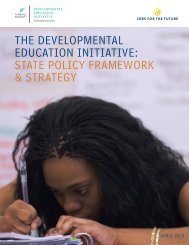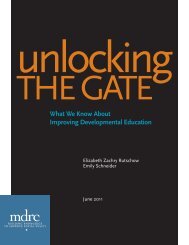Preparing High School Students for College - ERIC - U.S. ...
Preparing High School Students for College - ERIC - U.S. ...
Preparing High School Students for College - ERIC - U.S. ...
- No tags were found...
You also want an ePaper? Increase the reach of your titles
YUMPU automatically turns print PDFs into web optimized ePapers that Google loves.
Chapter 1IntroductionIn his 2009 State of the Union address, President Obama pledged federalgovernment support to ensure that the United States has the world’s highestpostsecondary graduation rate by 2020 (Obama, 2009). One of the many challenges thatmust be addressed in order to achieve this objective is the problem of incoming collegestudents’ academic deficiencies. Even though many matriculating college students arerecent high school graduates, about 40 percent of traditional students take at least oneremedial course to prepare <strong>for</strong> college-level coursework (Attewell, Lavin, Domina, &Levey, 2006). The costs associated with this problem are high, both <strong>for</strong> taxpayers andstudents. Recent research estimates that $3.6 billion is spent each year in direct educationcosts <strong>for</strong> remediation in college (Alliance <strong>for</strong> Excellent Education, 2011). And studentswho place into remedial classes are less likely to complete a degree or certificate (Bailey,2009), resulting in significantly reduced wages over time.Scholars and policymakers contend that a key underlying cause of this problem isa fundamental misalignment between high school graduation standards and collegeacademic expectations (Callan, Finney, Kirst, Usdan, & Venezia, 2006; Venezia, Kirst, &Antonio, 2003). However, the research gives no indication that such a misalignment isinevitable. It is possible that fewer students would need remedial coursework uponentrance to college if postsecondary institutions took a more active role in facilitatingstudents’ transitions from high school to college. In fact, improving alignment throughclose coordination between the secondary and postsecondary levels may improvestudents’ college readiness and their outcomes in college.The current study aims to understand initiatives intended to improve alignment —herein called college readiness partnership programs. We examine a number of collegereadiness partnership programs that are currently operating in Texas and identify theirfeatures, targeted students, and intended outcomes. We also examine the partnerships thatcreated these programs.1





